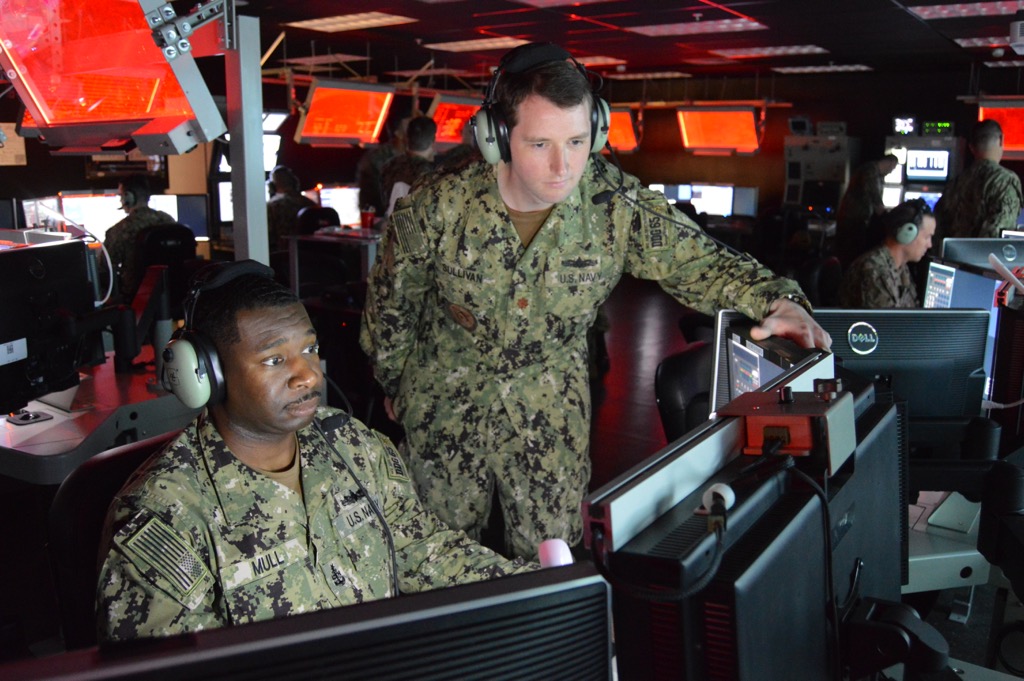
The surface navy continues to expand and evolve its use of virtual trainers, as it looks to train and certify individual sailors and watch teams ashore so they can make best use of their time at sea.
The Navy now fields systems as simple as a microphone paired with a simulator display screen to practice basic verbal commands and maritime “rules of the road,” all the way up to a top-of-the-line virtual training complex that allows combat information center (CIC) watch teams to rehearse scenarios against a specific enemy in a specific geography.
The Navy was already on a path to increase its usage of virtual training technologies – a path that was hastened by the 2017 fatal collisions and the fallout, including a 2018 snap assessment that showed most young officers had deficiencies in basic mariner skills. But in a year like this year, where the COVID-19 pandemic has made getting out to sea for training a bit more challenging logistically, the ability to cover so much ground in trainers ashore and then maximize at-sea time has helped the Navy stay sharp and ready for operations during a difficult year.
“Ships in the integrated phase are required to complete a 14-day sequester and test negative for COVID-19 prior to beginning at sea training exercises. Due to these bubble requirements, the use of simulators were vital in delivering training,” Commander of U.S. Naval Surface Forces Vice Adm. Roy Kitchener told USNI News.
Two of the Navy’s virtual trainers are available to sailors assigned to ships in lengthy maintenance periods, when they have limited options to practice their ship navigation or combat systems operations skills. Kitchener said these trainers didn’t replace at-sea training this year, though the trainers “are enabling crews to be better prepared to maximize effectiveness of at-sea events” once their ships are out of maintenance.
“Ships will continue to complete both at-sea and shore-based training as needed. Specifically, the [Afloat Training Group] Afloat Plan was designed to maximize uninterrupted at-sea time for ships exiting extended shipyard periods and accelerate each ship’s progress. In doing so, crews would gain at-sea experience more quickly; and ships could potentially be freed up for operational tasking ahead of schedule,” he said, though this is only possible if the crew shows up knowing how to do their jobs, which is where the virtual trainers come into play.
USNI News visited four virtual trainers on the San Diego waterfront on March 5, 2020, just prior to the COVID-19 pandemic forcing the Navy to implement safety measures such as physical distancing and mandatory mask-wearing. Kitchener told USNI News recently that “our combat systems and mariner skills training facilities did not experience any losses or reductions in training as a result of COVID-19. To maintain social distancing while in the trainer, we reduced training team sizes to minimum personnel. Safety mitigations in accordance with Center for Disease Control guidelines were implemented to maximize training sessions and minimize risk of spreading the virus.”
Additionally, he said, “to safely execute training in small enclosed spaces, we reduced training team sizes to minimum personnel, cleaned and sanitized in between each student session, and required personnel to wear face masks and social distance. We also took precautions to protect instructors considered high risk for the virus by minimizing their exposure in small spaces and requiring health checks prior to students arriving for training.”
CIAT
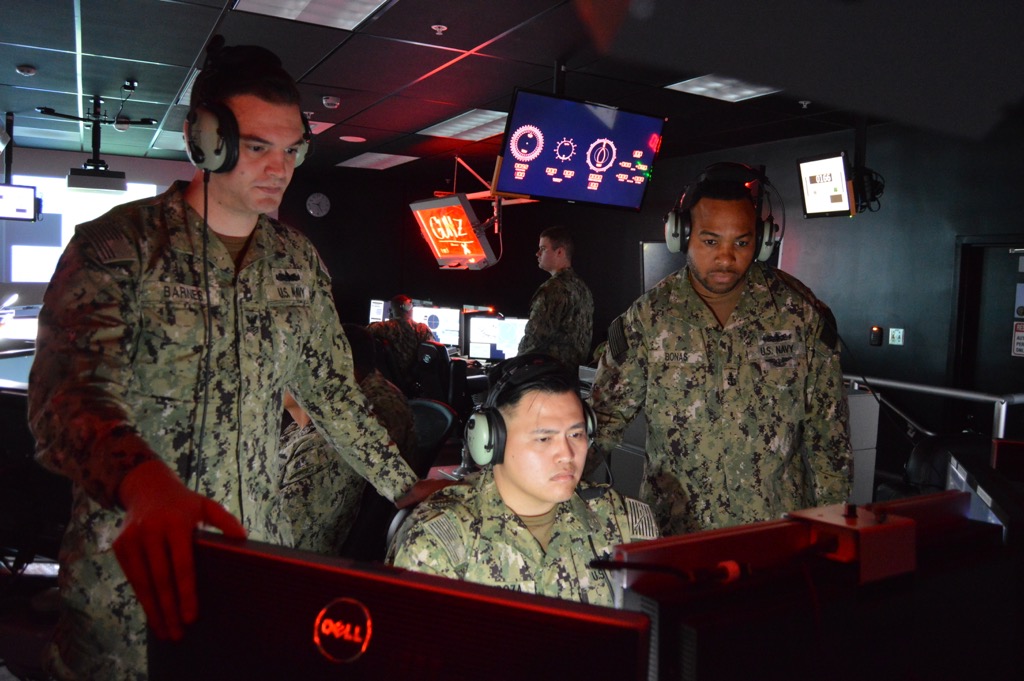
The top-of-the-line surface trainer the Navy now has in San Diego, Calif., and in Norfolk, Va., is the CIAT: the Combined Integrated Air and Missile Defense (IAMD)/Anti-Submarine Warfare (ASW) Trainer. Unlike previous trainers that focused only on the Aegis Combat System, CIAT covers all the sensors and weapons a ship crew could use while operating, allowing for a realistic experience for the entire watch team.
Though CIAT was originally designed for ship crews in a basic training phase of pre-deployment workups, “what we’ve realized very quickly is that, where CIAT really makes its money as a trainer is in the ad hoc capability that we can train sailors at any time, 365 days out of the year, in whatever they need. And really that’s what the ships are asking for right now. You’ve got ships that are going into multiple-month layups who have no opportunity to roll their combat systems suite into training. This is exactly like the ship – it’s not an emulation of the suite, this is the tactical code that is running on the warships you see on the pier,” said Lt. Aaron Van Driessche, an integrated air and missile defense (IAMD) warfare tactics instructor who served as the mission lead at CIAT during a USNI News visit earlier this year.
In a nod to CIAT’s intended mission, formal courses taught at CIAT by the Naval Surface and Mine Warfighting Development Center (SMWDC) and Naval Education and Training Command remain the top priority when it comes to scheduling time in the lab. Next in line is SMWDC for warfare tactics instructor (WTI) training and fleet tactics experimentation.
But any open spaces on the calendar can be claimed for ad hoc training, and that’s where Van Driessche said a lot of the power of CIAT is being seen.
Some of the best ships on the San Diego waterfront are making regular use of the trainer, with a handful claiming the same spot on the signup sheet every week – making time in the CIAT lab every Tuesday afternoon, for example, part of the crew’s routine.
As for the formal courses, in addition to training ship crews in the basic phase, the Navy is also seeing great benefit from bringing in crews whose ships are laid up in maintenance or not even delivered to the fleet yet.
In March, Japan-based USS Benfold (DDG-65) sent 31 sailors to the CIAT in San Diego as the ship was nearing the end of a 15-month maintenance period.
Lt. Cmdr. Kyle Sullivan, the combat systems officer on Benfold, said his crew might start interacting with Chinese and Russian ships even during pre-deployment workups, before the crew was re-certified to operate again following the lengthy maintenance period. Leadership decided to fly some of the most junior crew members to San Diego to train in the CIAT, so they’d be ready for whatever they faced once they got underway on their ship. Two full watch teams trained at the CIAT for two weeks, in the first time a Forward Deployed Naval Force-Japan ship had leveraged the San Diego CIAT.
Lt. Michael Harding, the destroyer’s fire control officer, said he was impressed with the fidelity of the CIAT. “It’s the most realistic training you can do short of doing it for real,” he remarked while he and others on his watch team were in the CIAT’s CIC.
“Short of actually going out there and shooting real missiles at real aircraft, or actually sending a real helo out there to identify real surface ships, hunting real submarines – you can’t get any closer to real than what we’re doing here. It’s a great time,” he said.
He added that, in previous shipboard trainers he’s used, there’s a template for the training scenario, and it’s easy to get complacent when the whole watch team knows that four simulated enemy aircraft will come in from a certain direction and conduct a certain maneuver. With the CIAT, everything can be changed – maybe six aircraft come in one time, Harding said, or maybe they fly a different pattern that makes them harder to target – and contractors in the control room can adjust the simulated enemy’s actions in real time based on what the watch teams decide to do.
Van Driessche said the enemy and the geography used for Benfold’s training was meant to replicate what they’d see in the South China Sea, their primary operating area as an FDNF-Japan ship.
“We build the scenarios from scratch,” he said.
“So this ship’s going to 7th Fleet: we’re in the South China Sea right now, we’re going to fight at Hainan Island in between the Paracels and the Spratly Islands, and we’re going to put them in the middle of a FONOP with a shadow getting overflown by Flounders. We put them in the environment they’re going to see as soon as they get back. But ships in Norfolk, they go to 5th and 6th Fleet. And there’s a CIAT in Norfolk that’s just like this, and when they customize the threats for them, okay, we’re putting you in the Strait of Hormuz, we’re putting you up the [Bab al Mandeb Strait], we’re putting you in a realistic environment outside of Syria where the threats are realistic and tailored to where they’re going to deploy to.”
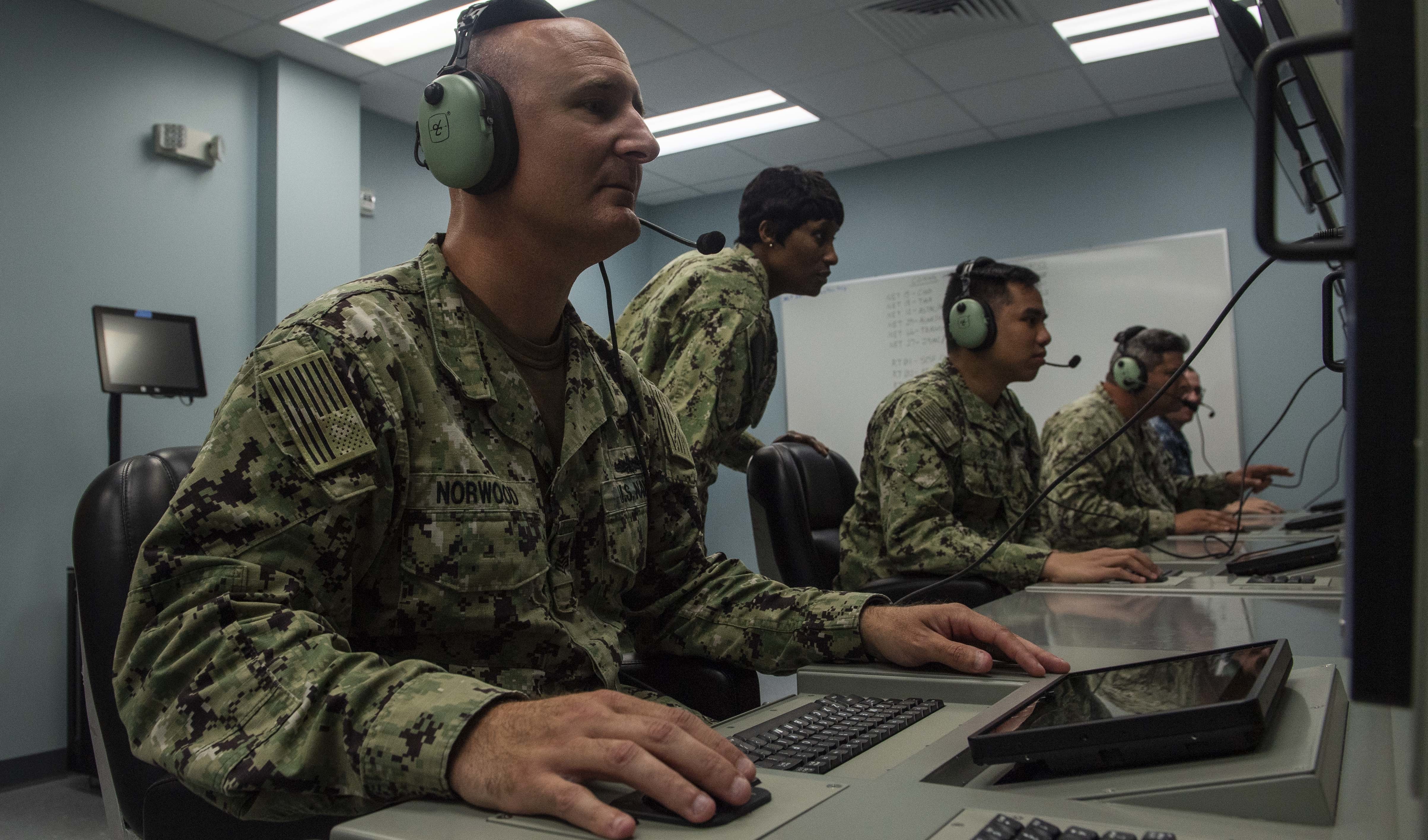
The fidelity of the trainer is so great that, in the sonar room, sonar technicians can “see” enemy submarines not only with the right signatures for that kind of submarine, but also correctly reflecting how sound travels through that particular body of water, with the right bottom topography and “every rock and mountain range under the sea” that an enemy sub might use to hide in.
Kitchener said the two CIATs – the San Diego one that opened its doors in December 2018 and the Norfolk one that opened in July 2019 – are operating at 100-percent capacity. Over the last two years, he said, the Navy has gotten better at figuring out how to make best use of time in the high-demand trainer.
“In addition to supporting Basic Training Phase events, CIAT is used extensively by ship crews for free-play in proficiency training, battle orders experimentation and watch station qualification events. One major lesson learned is to ensure ships scheduling free-play have solid training objectives established to ensure efficient and effective use of the lab. Crews have become more creative in how they leverage the trainer based on the experience they gain on the system,” he told USNI News.
“One area of effectiveness has been with CIAT providing a training venue for ships that are in extended availabilities to prevent watchstander skill atrophy and qualify new watchstanders. SMWDC is also expanding their use of the CIATs in support of their Surface Warfare Advanced Tactical Training (SWATT) events, Warfare Tactics Instructor (WTI) training and Tactics Techniques and Procedures (TTP) experimentation and validation.”
On-Demand Trainer (ODT) Trailer
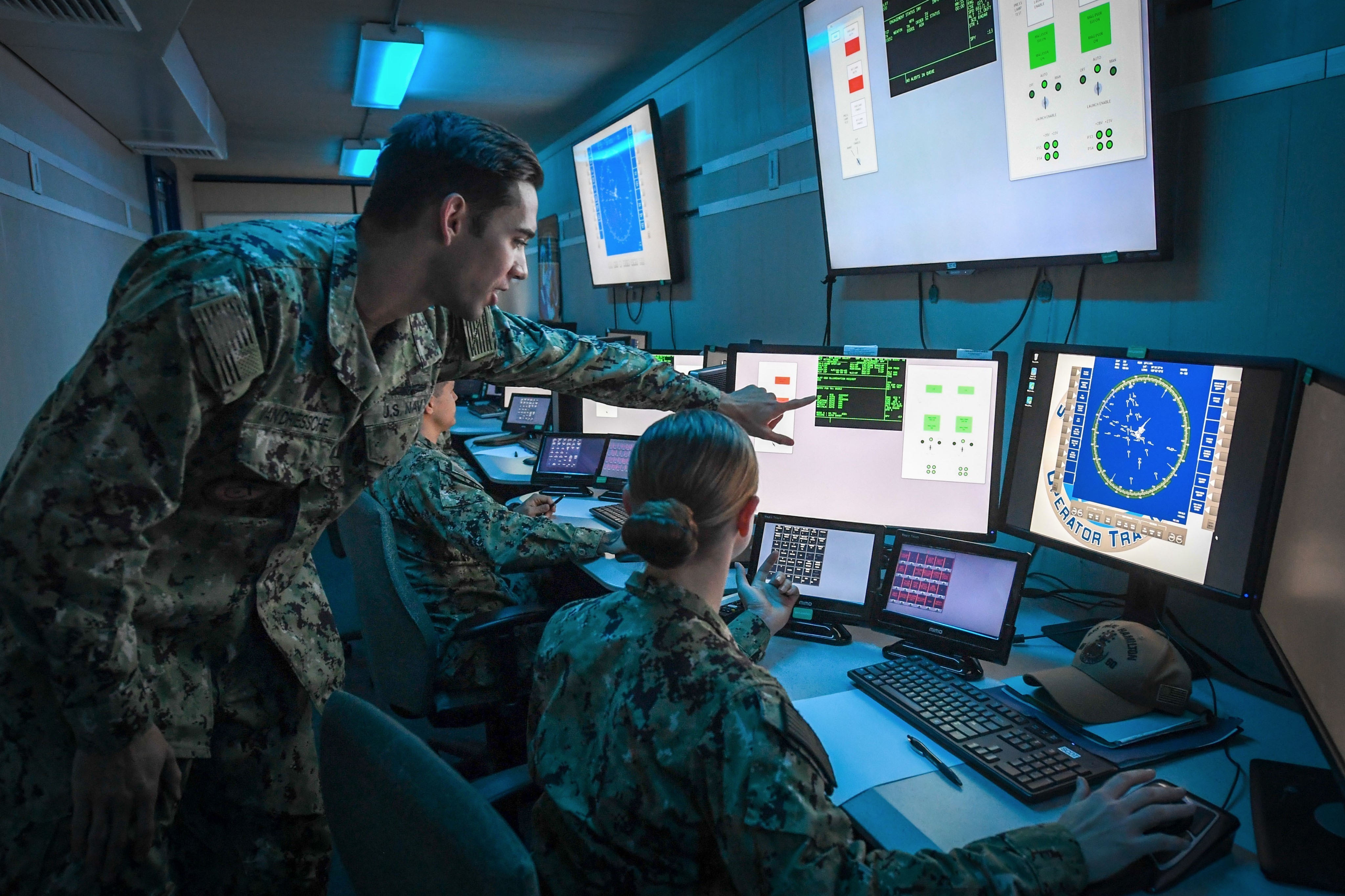
Less sophisticated but equally important for keeping crews proficient is the On-Demand Trainer (ODT), a simulator that sits in a 40-foot trailer that can be parked on the pier for use by crews whose ships are in maintenance or still in construction, or for additional mission-specific training for newer sailors.
“What’s great about this trainer is, it’s designed to really help sailors from the ground up: so sailors who are unqualified that are just trying to get used to signing into their consoles for the first time or become more familiar with a warfare area, ODT is absolutely a home for them,” Van Driessche said during a visit to the ODT.
The trailer has just six seats, which is enough to train in a specific mission area: just the air warfare team, or just the ballistic missile defense team.
Van Driessche said the trailer has two main purposes: it’s great for new sailors who aren’t even comfortable using the consoles yet and can help them acclimate to the work environment before they start tackling mission-specific work; and it’s good for teams to practice a single warfare area before heading into integrated training events with the entire watch team.
When USNI News visited ODT, the crew of the future Daniel Inouye (DDG-118), which has yet to be delivered to the Navy from builder Bath Iron Works, was training in the trailer. Without ODT, there would be nowhere for the partial ship crew in San Diego to train, meaning the sailors who had already reported to San Diego would be losing their proficiency with months of not practicing at Aegis consoles.
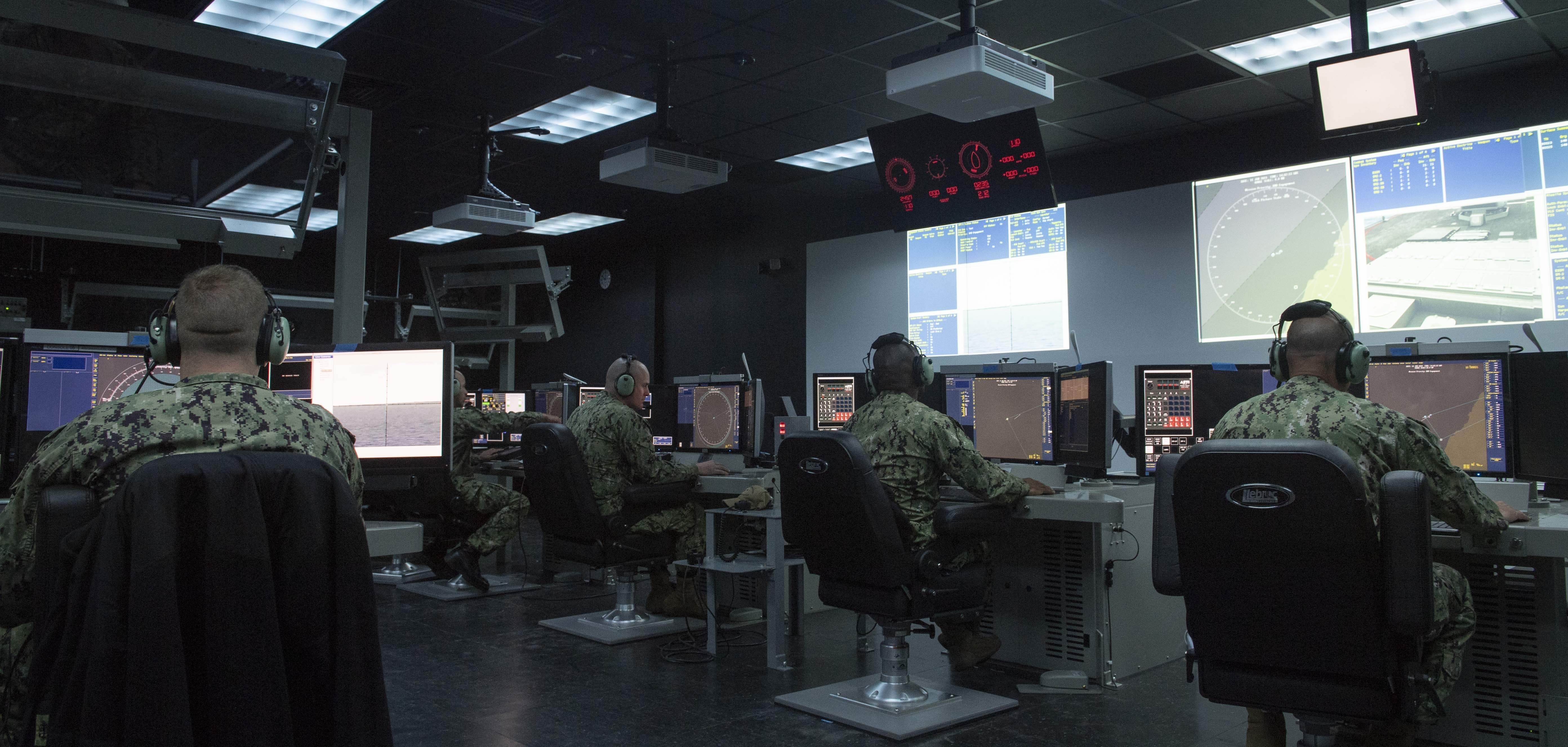
Van Driessche made clear that the ODT and CIAT aren’t in competition with each other, since they serve different purposes – integrated warfare operations versus mission-specific training. In fact, “ships who are really trying to impart tactical proficiency on their team are going to look at both [trainers’] schedules and find the best time to get their teams in there.”
Whereas the CIAT is exquisite, Van Driessche said it currently only operates Aegis Baseline 9 Build 18 software; the ODT is completely virtual and therefore can run any software build to reflect whichever ship a team is assigned to. ODT lacks sonar and other weapons and sensor integration outside the Aegis Combat System, and the training scenarios are more canned compared to CIAT’s customizable training events, but it has the benefit of allowing a specific team to train without affecting the rest of the crew. If a ship were in the pipeline to become BMD certified, the BMD team could train there to learn the new mission without dragging the entire ship crew through crawl-walk-run BMD training events, Van Driessche offered as an example.
Additionally, the $600,000 cost point of an ODT trailer compared to the $20 million for the CIAT makes it an attractive option for the Navy.
Earlier this year, trailers were set up in San Diego and Norfolk and were going to be transported to other fleet concentration areas in the Pacific Northwest and in Mayport, Fla., to highlight the portability of the trailer.
But bigger changes are on the way for ODT next year.
Kitchener told USNI News that the ODT will be evolving in 2021 and 2022 to meet a more specific need: training in the Aegis Combat System and the Ship Self-Defense System.
“The ODT architecture is being used to build and install an Aegis Virtual Operator Trainer (AVOT). AVOT’s will combine ODT functionality with shore-based legacy trainer labs in each surface ship homeport. AVOTs will also be installed at Aegis Training and Readiness Center in Dahlgren, Va., as well as the two Aegis shipbuilding yards in Pascagoula, Miss., and Bath, Maine,” he said.
“Labs will be procured and installed in [Fiscal Year 2021 to 2022], with the first sites in FDNF Yokosuka, Japan, and FDNF Rota, Spain. By installing shore-based AVOTs, we will have greater capability and accessibility for ship watch teams in every homeport and be able to support an increased number of trainees per session as compared to ODT. Additionally, each AVOT will be updated semi-annually to the latest Aegis computing software to stay aligned with shipboard combat system upgrades.”
The vice admiral added that “we intend to build upon the AVOT architecture and add Ship Self-Defense System (SSDS) MK II functionality to create an SSDS VOT in support of training for amphibious ships and aircraft carriers. The SSDS VOTs will use the same lab hardware as the Aegis VOTs and be capable of rapidly switching between Aegis and SSDS software loads. Investments will be needed to bring the SSDS VOT capability online.”
Littoral Combat Ship Trainer

If the key benefit of the CIAT is the ability to integrate all the combat systems, weapons and sensors into a single trainer for a realistic, integrated warfighting experience; and the benefit of the ODT is the singular focus on a single warfare area in a cheap enough trainer to field in numbers; then the highlight of the Littoral Combat Ship (LCS) Shore-Based Training Facility (LTF) is the extreme fidelity to the LCS experience, such that watch teams can actually be certified in the trainer before they ever step foot on an LCS at sea.
The LCS manning model has always relied on more crews than ships, with the current model calling for blue and gold crews for each hull and just a single training ship for every six crews. Hence, a land-based trainer that can supplement at-sea training is pivotal for getting crews ready to deploy, LTF staff told USNI News during a visit earlier this year.
A train-to-qualify course for individual sailors new to the LCS community helps them complete the majority of the personnel qualification standards for their new billet, creating a short process to qualify once they arrive on their LCS ship.
A train-to-certify course is for entire bridge and combat systems watch teams, who go through more than 20 scenarios as a group in the Integrated Tactical Trainer at LTF. After completing the course, they are certified for the basic phase of unit-level training in surface, air and electronic warfare, intelligence and navigation – in some cases, even before some watch team members have ever stepped onboard an LCS hull. The teams would then go on to advanced and integrated training under Carrier Strike Group 15 and SMWDC before deploying.
The training complex includes not only the Integrated Tactical Trainer – the high-fidelity simulator with the same seats, consoles and layout as the ship’s bridge and combat center – but it also has mission bay trainers, where Conex boxes with mission package gear are set up, along with the cranes, cradles and forklifts used to move the gear around, to help sailors learn how to operate the surface warfare, mine countermeasures and anti-submarine warfare mission packages that the ships will ultimately deploy with.
Mariner Skills Training Center
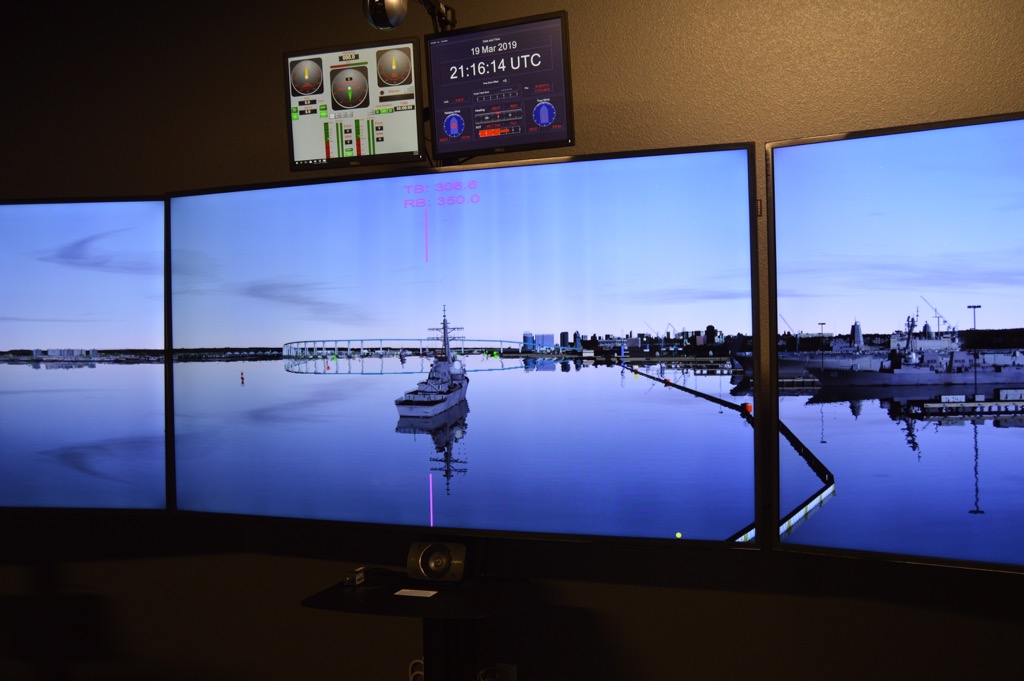
The Junior Officer of the Deck trainer at the Mariner Skills Training Center is much simpler than its counterparts in the LCS and surface combatant communities, but it serves a documented need.
A 2018 snap assessment showed major deficiencies in young watchstanders, who did not fully understand navigation, seamanship and ship handling principles and terminology. A course already being assembled on a small scale at the Naval War College in Rhode Island was expanded and quickly set up in San Diego and Norfolk: following nine weeks of the basic division officers course, ensigns now come to the Mariner Skills Training Center for four weeks, which includes 80 hours in the classroom and 80 hours in a simulator, said Capt. Ian Scaliatine, who directed the MSTC in San Diego earlier this year and has since left to work at the Surface Warfare Officers School Command.
The course was stood up rapidly to meet an urgent need, with the center in San Diego stood up in a temporary facility with 10 sets of simulators. By April 2019, staff started showing up at the facility, and a few months later all new officers were required to come through this course before showing up at their assigned ship.
Scaliatine and Carl Meuser, a retired Navy captain and the senior Junior Officer of the Deck instructor at the San Diego center, told USNI News that the course has nothing to do with the jobs and departments each officer will be assigned to, but instead is an intensive course on ship driving and rules of the road.
The simulator is relatively simple: three large screens in front of the students show a view from a ship bridge while operating in various locations, such as open ocean, straits, harbors and more. The students make sense of what they can see visually – ship outlines during the day, and ship lights at night – as well as information they’re given from radar tracks, automatic identification system (AIS) and other sensors, and then they give verbal commands to their simulated watch team. The simulator responds to the verbal commands, changing the course of the ship as directed and showing the students whether they’d make it out of the scenario safely or find themselves on a collision course with local shipping traffic.
Scaliatine said the simulator has less impressive graphics and lower fidelity to an actual ship bridge than something like the LCS trainer, but the low cost allows the Navy to field it in numbers.
By the middle of 2021, he said, the Navy would go from 26 simulators – 10 each in San Diego and Norfolk, and six in Rhode Island – to 78 total, including 30 each in San Diego and Norfolk and expanding to overseas Navy hubs. To keep up with the expansion, the MSTC in San Diego will grow from about a dozen instructors to about 56, and the four-week course will expand to six weeks in the Officer of the Deck Phase I course and three weeks in the subsequent OOD Phase II course, as part of an overhaul of young officer training.
Scaliatine said everyone so far has completed the curriculum and graduated the course, but he’s reached out to the future commanding officers of some ensigns who showed deficiencies, to alert them of where their new officer would need follow-on training after joining the ship crew.
Meuser made clear, though, that even students with “significant concern,” or the worst classification, are still showing up to ships much better prepared than a young officer who didn’t go through the JOOD course. The standard students are graded against, he said, is how a qualified officer of the deck on a deployed ship should be performing, not how a new ensign should perform – so given that tough standard, “they are still far better able to plug into the watch bill immediately upon walking onboard,” even if they leave the course with some deficiencies for their new CO to work on with them.





